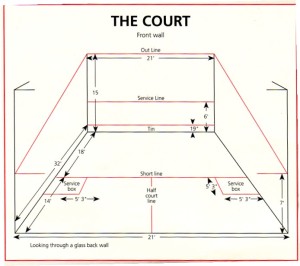|
SCORING – MEN
The first player to score 11 points wins the game. Every point counts whether serving or not. At 10 all players must win by 2 clear points, e.g. 12-10, 16-14. A match consists of the best of five games, and players are allowed a 90 second rest between games.
SCORING – WOMEN
Same as above but games go to 15 points. At 14 all, players must win by two clear points, e.g. 16-14, 18-16, etc.
NB: Both scoring systems are sanctioned and either one can be used if both players agree beforehand.
WARM-UP
Before the start of play, players have 5 minutes to warm up the ball together (2 1/2 minutes on each side of the court).
SERVE
The right to serve first is decided by the spin of a racquet. The server continues to serve until losing a rally. The opponent then becomes the server and so on throughout the game. The player winning the previous game, serves first in the next. At the beginning of each game and at the first opportunity to serve after winning a rally, the server may serve from either side of the court. If the server continues to score points, he or she must then serve from alternate sides of the court. If the serve is from the wrong side, there is no penalty, but the server must then serve from the correct side.
To serve, a player must, while having at least one foot in the service box, drop or throw the ball and strike it so that it travels directly on to the front wall between the service line (the red line approx. 6 ft. from the floor extending across the front wall) and the out line at the top of the front wall. The ball must land in the back half of the opposite court on its return from the front wall, though it may touch the side wall or back wall first. The ball must not touch the walls or floor before being struck by the server. Only one serve is allowed.
PLAY
After a correct serve, players alternate hitting the ball until the rally ends, that is, when it is no longer possible to make a good return. A good return is one in which the ball is returned before the ball bounces twice, is returned above the tin, does not hit the ceiling or any wall on or above the out lines, and, at some point, touches the front wall. The ball may strike the back or side walls in any combination in its flight toward or away from the front wall.
INTERFERENCE
Interference occurs when one player hinders the opponent’s choice of movement to the ball or the striking of the ball. To indicate interference, the player interfered may call a “let.”
LETS
Lets are called out loud by the player who has suffered interference. When a “let” is called, the rally does not count and is replayed. Lets are used for safety to protect players from dangerous situations such as being hit with the ball or racquet.
COMPLETE RULES
Squash Canada publishes official rule books (with World Squash Federation guidelines) which are also available from Squash BC.
|
. |

Click on the image for large view
EQUIPMENT AND SAFETY
BALLS
The double yellow dot (super slow) is used for all tournament play, but other speeds are available for recreational activity.
RACQUETS
Racquets are made from metal (aluminum) or graphite composition (fibreglass, boron, and graphite). Choose one that is the right weight and balance for you. Absorbent grips are recommended to prevent the racquet from slipping in the hand.
SHOES
Shoes must have non-marking soles, strong heel and arch support and should not be raised. Shoes for outdoor activity must not be used because they collect mud, dirt, clay, or other material which can be left on the court, causing slippery and dangerous conditions.
EYEGUARDS
Eyeguards are protective equipment designed to protect the eyes from the impact of ball or racquet. Eyeguards that meet these standards have polycarbonate lenses. It is strongly recommended that all players wear suitable eye protection when on court. It is mandatory for juniors (19 and under).
CLOTHING
Wear loose comfortable clothing designed for tennis or squash play. Two pairs of socks are recommended for players who otherwise suffer from blisters on their feet.
For advice on equipment and safety, please contact:
Squash BC (www.squashbc.com) or
Squash Canada (www.squash.ca)
|